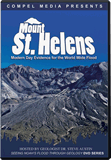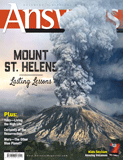
Remembering a Catastrophic Classroom
Mount St. Helens
Forty years ago, one of the most violent natural disasters of our modern time unfolded on May 18, 1980. The eruption of Mount St. Helens in Washington State killed 57 people, caused $1 billion in damage, and demolished over 230 square miles of property.
Despite the tragic loss of life and property, the devastation of the eruption site gave creation scientists a real-world example of how quickly catastrophic processes reshape the earth, as well as how quickly wildlife can recover—such as after the worldwide flood of Noah’s day. Even secular geologists, who believe slow evolutionary processes shaped our world, marveled at how quickly new geological features formed after the blast, and how soon the environment returned to full health.
This calamitous event not only challenged the prevailing belief that many geological features require millions of years to form, but also provided explosive evidence to help us understand the cataclysmic power of the flood and the designs that helped plants and animals repopulate the earth.

1. Rapid Cooling: The Mount St. Helens eruption blasted pulverized rock and ash 16 miles (26 km) into the atmosphere, coating 11 states and parts of Canada in dust. That ash cloud covering a small portion of the globe cooled the earth by a fraction of a degree. But evidence in the earth’s rock layers indicates that many enormous volcanic eruptions occurred during and immediately after Noah’s flood. If the comparatively small Mount St. Helens eruption lowered the earth’s temperature, multiple post-flood volcanic eruptions would have easily contributed to the rapid onset of the ice age.
2. and 3. Rapid Soil and Animal Recovery: Within a year, even the most devastated areas showed signs of life, such as gophers and bacteria, mixing the soil and restoring ecosystems. A decade later, with vegetation growing back, many animal species returned to Mount St. Helens to populate the once sterile landscape. Secular scientists marveled at the ability of living things to thrive in a once-barren environment. Similarly, after the flood, many kinds of creatures could have spread over the earth, churning the soil to prepare fertile areas for plants to grow and other animals to live. With its nutrient-rich sediments and abundance of water, the post-flood world presented unimaginable possibilities for life.
4. Rapid Canyon Formation: Geologists usually assign long timescales to the erosion of deep canyons. During and immediately after the flood, deep canyons could have formed very rapidly, including the Grand Canyon of Arizona. The Mount St. Helens eruption showed that a rush of muddy water can quickly carve canyons even in hard rock. During the global flood, rapid erosion processes would have happened on a much larger scale than we can imagine.
5. Rapid Layers: Following the volcanic blast, landslides, mudflows, and falling ash produced a sequence of sediment layers up to 600 feet (180 m) thick. This demonstrated that sedimentary layers can form very rapidly by catastrophic flow processes, such as those which occurred during the Genesis flood. Though slurries of volcanic ash and waterborne mud may behave a bit differently, the processes are essentially the same.
6. New Lava with Old Radiometric Dates: In 1996, geologists sent a sample from a 1986 lava flow in the crater to be radiometrically dated. Though the rock had formed only 10 years earlier, the potassium-argon method dated it at 350,000 years old and minerals in it at up to 2.4 million years old. This dating method—widely used by evolutionary geologists—is often highly inaccurate because it is based on faulty assumptions about conditions when and after the rock formed. These erroneous old dates that contradict the biblical timeframe must be radically adjusted.
7. Vertical Floaters: When Mount St. Helens blew, the trees in surrounding forests broke like twigs and many were dumped into nearby Spirit Lake. Some trees were buried in three feet of mud, standing straight up. Yet, had secular geologists not witnessed this process, they could have misinterpreted these upright-buried stumps as representing multiple forests that grew at different periods over many thousands of years. Indeed, they apply this misinterpretation at other sites with petrified upright logs, such as at Specimen Ridge in Yellowstone National Park.
Answers Magazine
July–August 2020
It’s always nice to have something as humble as the llama helping to guard the truth of God’s Word.
Browse Issue SubscribeRecommended Resources

Answers in Genesis is an apologetics ministry, dedicated to helping Christians defend their faith and proclaim the good news of Jesus Christ.
- Customer Service 800.778.3390
- © 2024 Answers in Genesis







